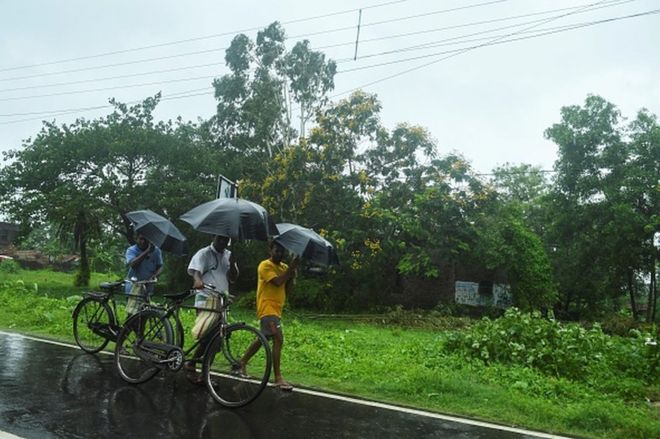Heavy rains and winds are lashing parts of eastern India and Bangladesh as a super cyclone approaches.
Both countries have evacuated millions of people in preparation for Cyclone Amphan, which is coming in from the Bay of Bengal.
The first super cyclonic storm in that area in two decades is forecast to cause deadly storm surges.
The coronavirus and social-distancing measures have made mass evacuations more difficult for authorities.
India’s weather department tweeted that Amphan was on course to make landfall “between afternoon and evening” local time.
It will first hit the Sundarbans, a mangrove area around the India-Bangladesh border, and then move north and north-eastwards near the major city of Kolkata in West Bengal state, Indian meteorological officials said.
Amphan is then expected to move further into Bangladesh on Thursday.

“At least 50 people took shelter in my concrete-built house,” Bangladeshi prawn farmer Abdur Rahim, who lives on on the edge of the Sundarbans, told the AFP news agency.
“There is panic. The women are worried… A few months ago Cyclone Bulbul smashed our village, destroying at least 100 homes. We hope Allah will save us this time.”
India and Bangladesh have asked for schools and other buildings to be turned into temporary shelters – but they need more space than usual in order to house people while maintaining social distancing.

Police in West Bengal, which along with the state of Orissa (also known as Odisha) is expected to be the worst-hit part of India, told the BBC that people were unwilling to go to the shelters because they were afraid of contracting Covid-19.
Amphan is the first super cyclonic storm in the Bay of Bengal since the 1999 super cyclone that killed more than 9,000 people.

Amphan is expected to hit the coast with winds gusting up to 185km/h (115mph) – the equivalent of a Category Three hurricane.
Officials in Bangladesh fear it will be the most powerful storm since Cyclone Sidr killed about 3,500 people in 2007. Most died as a result of sea water surging in.
While the storm’s current wind speed is likely to reduce slightly before it makes landfall, India’s weather department is predicting storm surges as high as 10-16 feet (3-5 metres). The rising of sea levels in this way can send deadly walls of water barelling far inland, devastating communities.
The cyclone comes as tens of thousands of migrant workers continue to flee cities for their villages during India’s lockdown to curb the spread of coronavirus. West Bengal and Orissa are among the Indian states seeing large numbers return.
Orissa has cancelled trains that were due to arrive with thousands of migrants between 18 and 20 May. Some district officials have barred entry and asked the state government to accommodate the migrants – many of whom are walking home – elsewhere until the storm passes.
Both states have halted air traffic as well.
Bangladesh’s disaster management minister earlier told the BBC that authorities there planned to evacuate about two million people – an operation they expected to continue into Wednesday morning.
Extra shelters have been prepared to allow for social distancing, while masks are also being distributed.
However, there are fears for hundreds of thousands of Rohingya refugees who fled Myanmar and live in camps in the country. The main camps are not in the direct path of the storm but Bangladeshi officials said they had moved hundreds of Rohingya living on an island in the Bay of Bengal into shelters.
Meanwhile state officials in India are struggling to find shelters for evacuees. In Orissa, for instance, 250 of the more than 800 existing shelters are being used as coronavirus quarantine centres.


